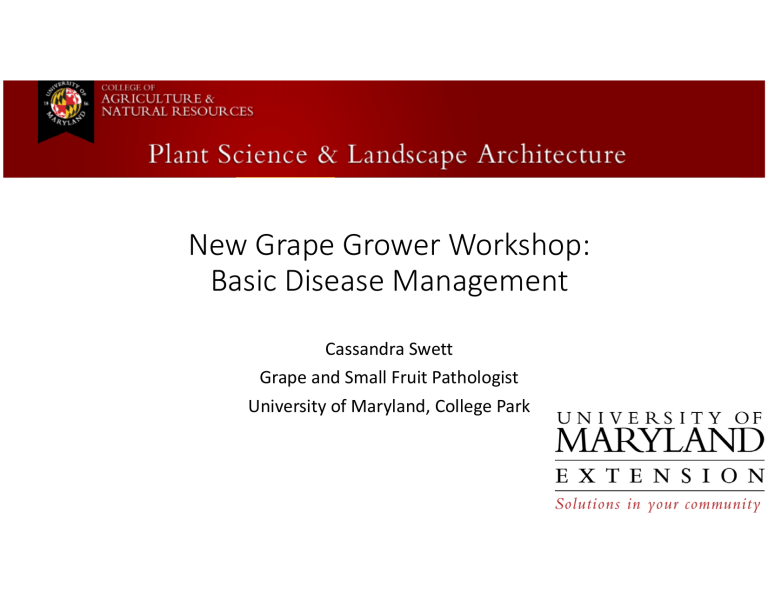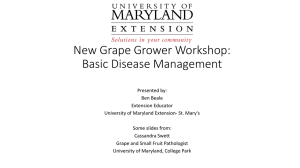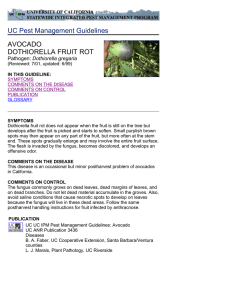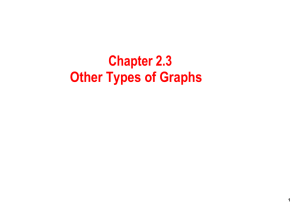New Grape Grower Workshop: Basic Disease Management Cassandra Swett Grape and Small Fruit Pathologist

New
Grape
Grower
Workshop:
Basic
Disease
Management
Cassandra Swett
Grape and Small Fruit Pathologist
University of Maryland, College Park
Why do diseases matter?
• Reduce fruit marketability and fruit / wine quality
• Fruit rot and fruit blemishing
• Reduce vine vigor reduced yields
• Foliar leaf spot and mildews
• Cane diseases
• Trunk cankers / galls
• Root rot
• Systemic diseases (viruses, Peirce's disease)
• Shorten longevity of the vineyard
Disease Management Timeline
Vineyard development:
• Buy virus ‐ free certified planting stock
• Select varieties appropriate to the environmental conditions in your region
• Stress results from mis ‐ matching varieties to region leads to disease problems
• Select resistant varieties where appropriate
• Learn which diseases are most problematic in your region
• There are resistant varieties for many but not all diseases
• Site selection: water drainage, proximity to woods, warmer areas for less ‐ cold tolerant varieties
Starting in year 1
• Chemical control
• Non ‐ bearing years: prevent early mortality, maintain vine health, and reduce inoculum
• Esp.
Mildews, Phomopsis, Black rot, Trunk diseases
• Canopy management and timing of pruning
• Good sanitation: rouge infected vines, removal / burial of infected debris / fruit, avoiding contamination
• Harvest management: minimize vine stress
• Nutrition: minimize host stress
Important principles for disease management
1.
CHEMICALS.
Fungi are the only pathogen group you can control with chemicals
All major fungal pathogens are at risk of becoming resistant to single site of action chemical groups
Know your FRAC groups: Rotating FRAC groups is a MUST
2.
TIMING.
Fungal pathogens vary timing of chemical control
Scouting and accurate disease identification are key to effective chemical use
Understand the environmental conditions under which you need to spray
3.
CANOPY MANAGEMNET.
Critical for control fungal fruit, leaf and cane diseases
Reducing humidity reduces infections
Canopy management increases penetration of pesticides
4.
INOCULUM SOURCES.
Reduce disease pressure and epidemics of fungal diseases by managing overwintering inoculum
If survival is in wood: Dormant sprays kill overwintering inoculum on wood
If survival is in berries, canes, and debris: Remove from the canopy; spring cultivate, mulch, remove or burn to suppress spread
Important principles for disease management
5.
CLEAN STOCK.
Important for ALL plant pathogens, but is the ONLY preventative management option for viruses and crown gall
6.
Only some things can be cured
‐ There is no cure for viruses, crown gall, root rot or trunk canker diseases
‐ Once it’s in the plant, removal is the only option
Disease management: Fungal pathogens of fruit
#1 Cause of yield loss and poor fruit quality
‐ Very common
‐ Control: canopy management, fungicides, sanitation, resistance
#2.
Viruses: Grapevine leaf roll and Grapevine red blotch
‐ Reduce vine vigor
‐ A common contaminant in non ‐ certified nursery stock
‐ Control options: clean stock and vine removal
#3.
Agrobacteria (crown gall):
‐ Kills vines
‐ A big problem in cold years
Fruit diseases with a single infection period within the season
For these kinds of diseases, continuous protection through the season is not necessary
PRIMARY INOCULUM
Phomopsis cane and leaf spot (and fruit spot)
Diagnostic symptoms:
‐ Black spots and scabs on green shoot
‐ Old shoots bleached with black spots
Inoculum in wood
Spray from 1” shoot growth through fruit set
FACT SHEET FOR PHOMOPSIS: http://nysipm.cornell.edu/factsheets/grapes/diseases/phomopsis.pdf
Disease with multiple infection periods within a single season
Most fruit pathogens in this region have multiple infection cycles
For these kinds of diseases, you can get epidemics that reduce yield or result in no yeild
To prevent epidemics it is necessary to protect throughout the season, or until berries are no longer susceptible
Black rot
Epidemics can cause major yield losses
Diagnostic symptoms:
‐ Red leaf spot with small black bodies
‐ Blackening of immature berries starting early in the season
Pre ‐ bloom to 2 weeks post bloom is the most critical spray time
Berries become resistant with age: may have to spray until 6 weeks post bloom
FACT SHEET FOR BLACK ROT: https://grapesandwine.cals.cornell.edu/newsletters/appellation ‐ cornell/2014 ‐ newsletters/issue ‐ 17/managing ‐ black ‐ rot
Downey mildew
Epidemics cause major yield losses
Diagnostic symptoms
‐ Leaf spots with white powder on leaf underside
‐ Developing fruit also become infected
Overwinters in soil debris
Berries become resistant with age
Spray when cloudy, warm and wet
Use DM specific fungicides for effective control
Canopy management is critical
FACT SHEET FOR DOWNY MILDEW: http://nysipm.cornell.edu/factsheets/grapes/diseases/downy_mildew.pdf
Downy mildew is easily confused with Powdery mildew
Controlled VERY differently
How to tell them apart:
DOWNY: White mildew is on leaf underside
POWDERY: White mildew is on leaf top
Powdery mildew control
‐ Overwinters in wood
‐ Canopy management critical
‐ Secondary spread is most affected by temperature
‐ Repeat infections occur below 90 F
Sulfur is the most effective control, if varieties are not sensitive
FACT SHEET FOR POWDERY MILDEW: http://www.practicalwinery.com/marapr03/marapr03p16.htm
Botrytis bunch rot and ripe rot
Botrytis bunch rot
Symptoms: grey / brown spores on fruit, dead blossoms, and other dead tissue
Ripe rot
Symptoms: berry shriveling and browning; black specks on surface
• Botrytis bunch rot and ripe rot pathogens infect flowers at bloom
Bloom ‐ time fungicide applications critical to protect flowers
• Pre ‐ harvest applications after bloom to protect developing and ripe fruit, if disease pressure is high
• Canopy management is critical for these diseases
Not the same as sour rot
• Characterized by sour odor
• Considered to be a secondary effect of disease or other berry damage
• Insects might be important in this region
• No fungicides available
• Avoid damage / other diseases
• Control of insects may also be important
FACT SHEET FOR FRUIT ROTS: http://www.sites.ext.vt.edu/newsletter ‐ archive/viticulture/06march/06mar.html
When do you manage fungal fruit diseases?
It depends on the disease!
Plants are at greatest risk between pre ‐ bloom and post bloom, for most fungal diseases
Management
of
other
important
diseases
in
the
region
Grapevine leaf roll virus
About 25% of vines with premature senescence symptoms are GvLR
Tested for in clean stock programs
Mealy bug vectored in the vineyard
Grapevine red blotch virus
Newly described disease
About 21% of vines with premature senesce symptoms are GvRB—hard to distinguish from GvLR
Not yet tested for
Graft transmissible; Vector unknown
FACT SHEETS: http://www.nysipm.cornell.edu/factsheets/grapes/diseases/grape_leafroll.pdf
http://fpms.ucdavis.edu/WebSitePDFs/news/RedblotchFactSheet.pdf
Grapevine leaf roll and Grapevine red blotch viruses
‐ Reduce vine vigor
‐ A common contaminant in non ‐ certified nursery stock
‐ Control options: clean stock and vine removal
#3.
Agrobacteria (crown gall):
‐ Kills vines
‐ A big problem in cold years
Crown Gall: Agrobacteria
‐ A big problem in cold years: facilitated by winter injury
‐ Kills vines
‐ Clean stock; avoid cold locations for sensitive varieties
FACT SHEET: http://nysipm.cornell.edu/factsheets/grapes/diseases/crown_gall.pdf
Trunk cankers (many fungi)
‐ Will reduce longevity of vineyards over time
‐ Present in ~15% of vines in this region
‐ Control: clean vines, pruning in the spring / double pruning; minimize harvest / nutrient stress
Pierces disease (a bacteria)
‐ Southern and eastern shores
‐ Proximity to woodlots very important
Insect vector survives on alternate hosts
‐ Control: cut out diseased canes
Minor viruses
‐ Clean nursery stock
Not
everything
is
a
disease:
Here’s
some
confusing
look
‐
alikes
Symptoms associated with fruit rot and fruit deformation can look a lot like…
Insect damage:
American grape berry moth
Sun / heat damage
It can get confusing because insect and sun damaged fruit can later develop disease, such as sour rot
Use regular scouting to stay informed
FUNGI: typically cause small spots
Foliar spot and blight symptoms caused by
BACTERIA: Early color / blight VIRUSES: Early color
FUNGI: But can also cause blight
Herbicide damage
Can look like…
Nutrient deficiency
Mildew symptoms caused by powdery and downy mildew can look like…
Chemical residue
Decline of young and old vines resulting from root rot, trunk disease, or systemic infections (viruses and bacteria)
FUNGI BACTERIA VIRUSES
Can look like
Herbicide damage Cold injury
And in early years, premature senescence can be difficult to differentiate from physiological processes
Online
resources
• Cornell: disease fact sheets, spray guides and yearly newsletter from
Wayne Wilcox http://www.fruit.cornell.edu/grape/IPMGeneral.html
• Virginia tech: Blog by Mizuho Nita, with links to disease fact sheets and spray guides http://grapepathology.blogspot.com/
Books
/
other
resources
• A Pocket Guide for Grape IPM Scouting of Grapes in North Central & Eastern U.S.
• APS Compendium of Grape Diseases
• Vineyard Pest Management Tool Kit.
VineSmith
Vineyard Services.
Available for $59.00+ S&H from http://www.vinesmith.com/tool ‐ kit
• Guidelines for Developing an Effective Fungicide
Spray Program for Wine Grapes in Maryland,
2012
Thank you
Questions?
Cassandra Swett
Email: clswett@umd.edu




